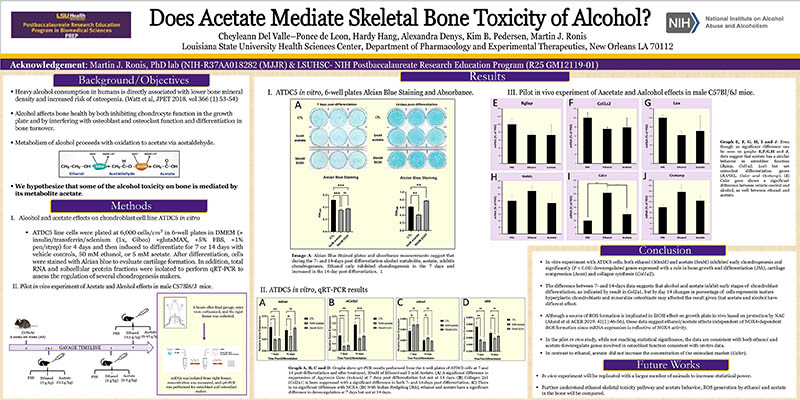
Hover to pan and click to magnify. Click again to pan at full screen.
Cheyleann Del Valle–Ponce de Leon, Hardy Hang, Alexandra Denys, Kim B. Pedersen, Martin J. Ronis
Cheyleann Del Valle–Ponce de Leon, Hardy Hang, Alexandra Denys, Kim B. Pedersen, Martin J. Ronis
Louisiana State University Health Sciences Center, Department of Pharmacology and Experimental Therapeutics, New Orleans LA 70112
ABSTRACT:
Excessive alcohol consumption in humans leads to increased risk for osteopenia. Alcohol can affect the bone by disrupting chondroblast differentiation in the growth plate and interfering with osteoblast and osteoclast function, differentiation and bone turnover. Metabolism of alcohol proceeds with oxidation to acetate via acetaldehyde. Literature estimates the amount of acetate going to the blood stream is ten times less the alcohol administered (Carmichael et al., 1993). We hypothesize that alcohol toxicity in the bone growth plate is mediated by acetate. We compared the effects of alcohol and acetate on a chondroblast precursor cell line ATDC5 in vitro. In ATDC5 cells cultured with chondroblastogenic medium, both ethanol (50mM) and acetate (5mM) inhibited Alcian Blue staining of cartilage and significantly (P < 0.05) downregulated marker genes associated with chondroblast differentiation (Ihh), (Acan) and (Col1a2). In a subsequent pilot in vivo experiment with 4 mice per group, we further compared 4 days of binge alcohol (3, 3,4 and 4.5g/kg) to 4 days of binge acetate (0.3, 0.3,0.4 and 0.45 g/kg) in male C57Bl6/J mice., we isolated femur shaft RNA and performed qRT-PCR for genes involved in osteoblast function and osteoclast differentiation. While not reaching statistical significance, the data trend that both ethanol and acetate downregulate genes involved in osteoblast function. Ethanol significantly increased the mRNA concentration of the osteoclast marker Calcr (P<0.05) while acetate had no effect. This experiment will be replicated with a larger number of animals to increase statistical power. In conclusion, acetate appears to imitate the deleterious effects of alcohol on several genes involved in chondroblast and osteoblast differentiation and function. (MJJR-R37AA018282, R25 GM12119-01)

DISQUS COMMENTS WILL BE SHOWN ONLY WHEN YOUR SITE IS ONLINE